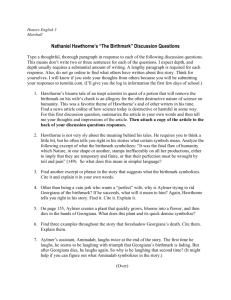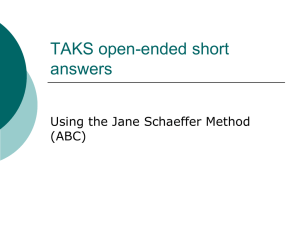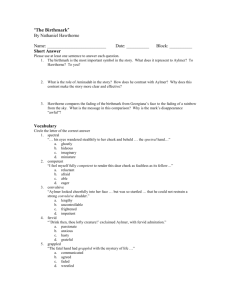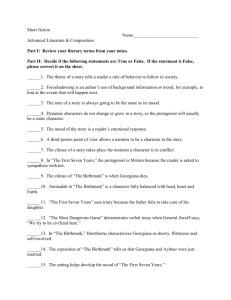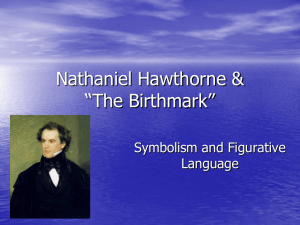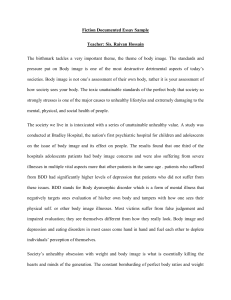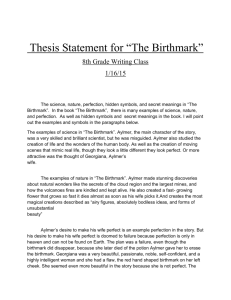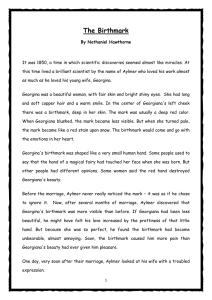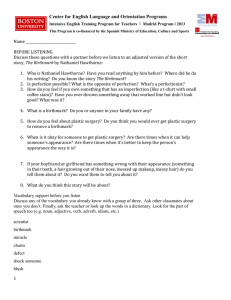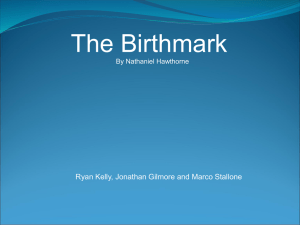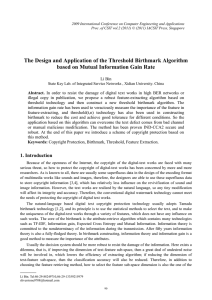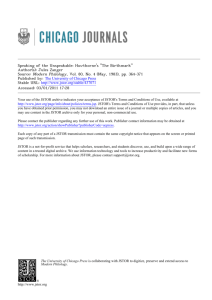ABC OER Strategy
advertisement
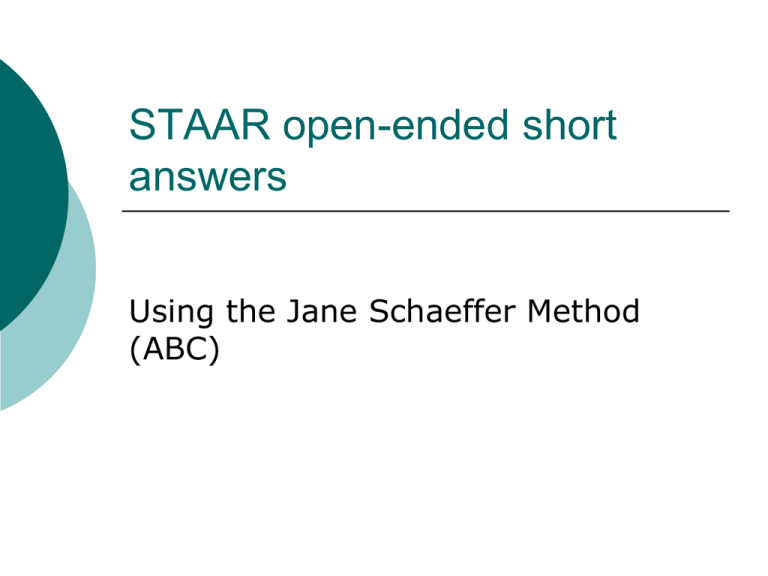
STAAR open-ended short answers Using the Jane Schaeffer Method (ABC) The Prompt Before writing anything, know your assignment— READ THE QUESTION! What are you being asked to do? Get Ready to Color Your World! Materials: When we write, we will use black, blue, and red pens. BLACK is the Answer (A) BLUE is for Proving with a quote (B) RED is for explaining a Connection (C) Sample Question How would you describe the third little pig in “The Three Little Pigs”? What are you being asked to do? Step 1- Answer the question A – Answer the question completely Your first sentence should reiterate the question and present your idea Answer the question… In the fairy tale “The Three Little Pigs,” the third pig is very wise. Step 2 – Bring in a quote B – Bring in a quote Start your sentence with your own words… Text Evidence = Supports for your answer (facts, quotes, examples, etc. from text) Text Evidence can’t be argued with—a quotation is evidence that supports your point and comes straight from the story. Bring in a quote… Remembering his mother’s warning about a wolf, he “builds his house out of sturdy brick.” The sentence begins with the writer’s own words/interpretation to set up a quote from the actual story. Step 3 - Connect C – Connect your quote to your answer through analysis, interpretation, explanation, or insight into how the text supports your opinion. Begin your commentary with: “This (action/trait) shows that…” Connect! This decision shows that the third pig is intelligent because he built his house out of strong materials to outwit the wolf. Does It Flow? Prompt: How would you describe the third little pig in “The Three Little Pigs?” In the fairy tale “The Three Little Pigs,” the third pig is very wise. Remembering his mother’s warning about a wolf, he “builds his house out of sturdy brick” and the wolf “huffed and puffed” but could not blow the house down. This decision shows that the third pig is intelligent because he built his house out of strong materials to outwit the wolf. Grading the TAKS Short Answers Scored on a four point scale 0 1 2 3 = = = = Insufficient Partially Sufficient Sufficient Exemplary Your score for each response will be based on your ability to write a reasonable answer and support it with evidence from the selection Evidence = direct quotation Sample Responses Let’s look at student samples and scores for the following prompt… Prompt: What did the author learn from her experience with the new student in “The Spoils of War”? Why do students score a “3”? Due to the student’s lack of participation in class, the author assumed he could not understand English, but she was proven wrong by his test, as she says, “I had never before sat transfixed in disbelief over a student paper.” The author called upon the mysterious student to explain his silence. “He was in a war, he said, and…was lost for a long time in the jungles of Vietnam…And after that”, he said, “…he couldn’t. He just found it hard to be with people. To speak to people.” She does not press the young man, but finds herself with a new perspective. This young man shared some of his suffering with her, and she learned that you didn’t have to be killed in a war to lose your life. ***Both the student’s ideas and choice of text evidence are strong. It is this combination that demonstrates the student’s depth of understanding. Why do students score a “2”? From her experience with the traumatized student the author learns that war has the power to inflict invisible wounds. After being lost “in the jungles of Vietnam,” this brilliant student cannot speak in classroom discussion and withdraws “as if attempting a disappearing act.” Even though his wounds don’t bleed, they cause him to feel pain and isolation. “TEXT-LIGHT” ***The student’s text evidence does not support the idea strongly enough to show a deep understanding; usually because there is not enough evidence presented. Why do students score a “2”? The author learned that appearances can be deceptive. At first the author suspects that the student is “barely literate” and that his silence is nothing more than “arrogance.” Later she learns that “He just found it hard to be with people, to speak to people” because he was “lost in the jungles of Vietnam.” While she doesn’t know what happened, she can clearly see that he has “an extraordinary mind” and “could do so much.” “IDEA-LIGHT” ***The student’s idea is not as strong as his text evidence. His idea may be too surface-level or too briefly explained to show a deep understanding of the selection. Why do students score a “1”? She learned from the experience that things happen earlier in a person’s life have a lasting effect on them. For example, since the student was lost in the jungle, he feels distant from other people because of that experience. ***The student does not understand the difference between a general text reference and text evidence. Why do students score a “1”? The author of “The Spoils of War” learns from her experience with the student that nothing can really help him because of the jungle. The boy stated, “Nothing can help” (paragraphs 15 – 19). ***The student includes both an idea and text evidence, but instead of supporting the idea, the text evidence merely repeats, or “ECHOES,” the idea. Why do students score a “1”? The author learned that the student did not have trouble talking because he was Spanish, but because he had been in a war and was lost in the jungle and he probably felt isolated from everyone else because of this. “You have a lot to say. You write like this and you sit in class like a statue?” **The student’s choice of text evidence may have some relationship to the idea but does not clearly support it. Why do students score a “1”? The author learned that she should not judge anyone by the way they appear. She initially thought him to be “illiterate” and full of “arrogance and scorn.” But as she read his paper and eventually talked to him, she discovered his “extraordinary mind” that was hidden by his experience in the war. This author had learned that she was wrong about what she thought about her student. “His face was severely impassive…Close up there was nothing arrogant about him.” ***The student’s text evidence is too partial to support the idea. Partial text evidence is usually a result of the student’s use of “snippets” (short phrases) only or omission of essential information through the inappropriate use of ellipses. Why do students score a “1”? She learned that she shouldn’t judge people by the way they look or from their behavior. “His first paper was a shocker. I was surprised to receive it at all – I had him pegged as a sullen type who would give up at the first difficult assignment.” She eventually learned that his war experiences wounded him and made it difficult to talk, even though he was brilliant. ***The student introduces a new idea by including a summary or commentary in the last sentence of the response. Why do students score a “1”? She learned a lot about her student. “The next day I called him over after class and asked if he was aware that he had an extraordinary mind. He said, yes, he was.” When she asked him what it was all about, he told her. ***The student does not explain the idea even though the question requires that he do so. Because of this, the response cannot be considered a sufficient answer. Why do students score a “1”? This author is even more opposed to the war after meeting the young man in her class. She gets to see a firsthand look at the “spoils of war” and learns what it can do to a person’s intelligence. She realizes that we are quick to defend our country, but do not come “to the defense of this country’s young men” to insure that their lives don’t become the “spoils of war.” ***The student includes multiple ideas but does not provide textual support for all of them. Why do students score a “1”? The author learned that things are not always what they seem. The student “always sat in the back row, as far away as he could get,” but when he turns in his first exam, the author says, “He knew Faulkner better than I did.” She didn’t know what to think. ***The student’s idea needs to be clearer and more specific – the idea may be general or somewhat vague. Why do students score a “1”? She learns that a person’s past can interfere with his present outlook on life. “He was in the war…He was lost in the jungles of Vietnam.” This is similar to what happened to my grandfather. He has problems, and my aunt says they all started when he was in Vietnam, just like the student in “The Spoils of War.” ***The student is not focused enough on providing a clear idea and text evidence; instead, he might waste space by relating his idea to people or things outside of the text. “…it was so often called a charm that I was simple enough to imagine it might be so” “I might wish to put off this birthmark of mortality by relinquishing mortality itself” “Remove it remove it whatever be the cost, or we shall both go mad” “Not even Aylmer now hated [the birthmark] so much as she” Sample response for “The Birthmark” – ABC STEP 1 – Answer Georgiana’s perception of the birthmark changes from believing that it makes her attractive to wanting it removed at whatever cost. Sample response for “The Birthmark” – AB(B)C STEP 2 – Bring in a quote Georgiana’s perception of the birthmark changes from believing that it makes her attractive to wanting it removed at whatever cost. When Aylmer asked Georgiana if she had considered removing her birthmark, she admitted, “it has so often been called a charm that I was simple enough to imagine it might be so.” However, right before Aylmer offers her the elixir, she stated, “I might wish to put off this birthmark of mortality by relinquishing mortality itself.” Sample response for “The Birthmark” – AB(B)C STEP 3 - Connect Georgiana’s perception of the birthmark changes from believing that it makes her attractive to wanting it removed at whatever cost. When Aylmer asked Georgiana if she had considered removing her birthmark, she admitted, “it has so often been called a charm that I was simple enough to imagine it might be so.” However, right before Aylmer offers her the elixir, she stated, “I might wish to put off this birthmark of mortality by relinquishing mortality itself.” This The conversations between Georgiana and Aylmer show that Georgiana’s perception of her birthmark changed drastically from the beginning to the end of the story. CROSSOVER Question – ABBC A similar characteristic that Heidi and Georgiana both share is that both women are willing to change their natural appearance for others. In “The Birthmark,” Georgiana aims to please Aylmer and says, ”Remove it, whatever be the cost or we shall both go mad!” She knows that Aylmer might go “mad” if she does not rid herself of the birthmark. In “Heidi Montag’s Plastic Surgery: Obsession or Addiction?” the author says Heidi was “teased when [she] was younger…which [made her] feel pressure to be more attractive.” Both women feel the pressure to change their appearance for others and eventually do so.
